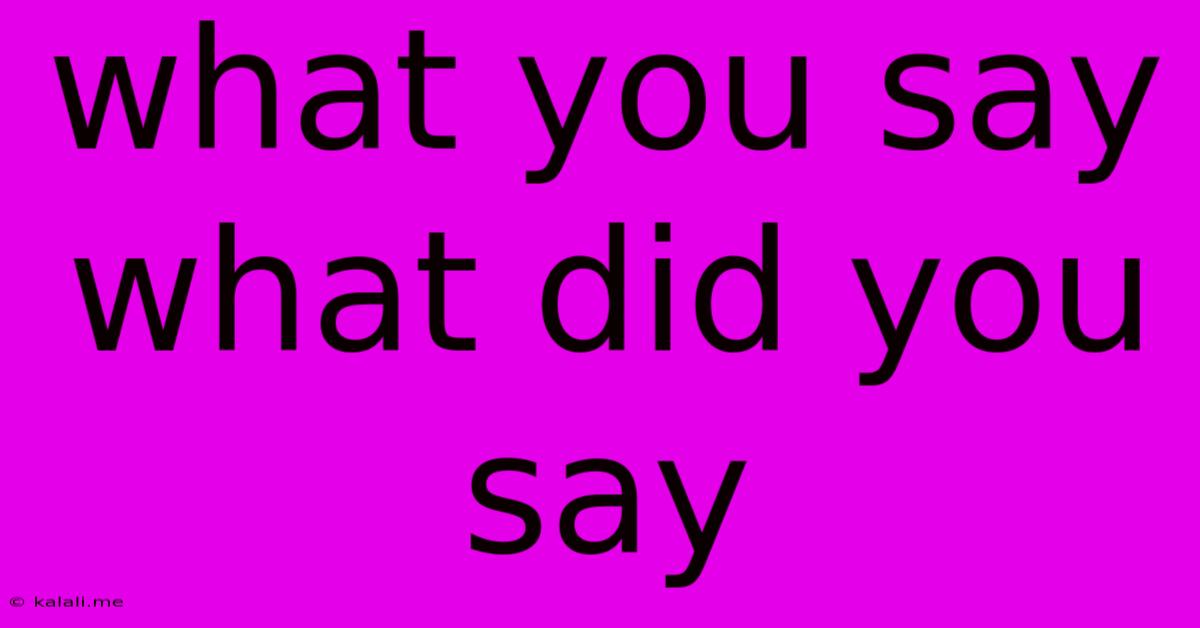What You Say What Did You Say
Kalali
May 25, 2025 · 3 min read

Table of Contents
What You Say, What Did You Say? Mastering Clear Communication in a Noisy World
The phrase "What you say, what did you say?" perfectly encapsulates the frustration of miscommunication. In today's fast-paced, often noisy world, ensuring your message is clearly understood is paramount, whether you're leading a team meeting, giving a presentation, or simply having a conversation with a friend. This article explores the crucial elements of effective communication and offers practical strategies to minimize misunderstandings and maximize clarity.
This guide dives into the nuances of effective communication, focusing on verbal and nonverbal cues, active listening, and adapting your style to different audiences. We'll examine how to structure your message for impact and provide techniques to ensure your point resonates with the receiver.
The Importance of Clear Communication
Clear communication is the bedrock of successful relationships, both personal and professional. Ambiguity can lead to:
- Missed deadlines and projects: Confusion about instructions or expectations can derail even the best-laid plans.
- Damaged relationships: Misunderstandings can breed resentment and mistrust, harming personal and professional bonds.
- Loss of credibility: Inconsistent or unclear messaging can damage your reputation and trustworthiness.
- Reduced productivity: Time spent clarifying misunderstandings takes away from valuable work time.
- Financial losses: In business, miscommunication can lead to costly errors and lost opportunities.
Mastering clear communication is an investment in your personal and professional success.
Elements of Effective Communication
Several key elements contribute to effective communication. Let's explore them in detail:
1. Choosing the Right Words:
- Simple language: Avoid jargon or overly technical terms your audience may not understand. Tailor your vocabulary to your audience's level of understanding.
- Precise language: Be specific and avoid vague terms. Use concrete examples to illustrate your points.
- Concise language: Get to the point quickly and avoid unnecessary wordiness.
2. Nonverbal Communication:
Nonverbal cues – your body language, tone of voice, and facial expressions – often speak louder than words. Ensure your nonverbal cues align with your verbal message. Maintain eye contact, use appropriate hand gestures, and adopt a confident posture.
3. Active Listening:
Active listening involves fully concentrating on what the other person is saying, understanding their perspective, responding thoughtfully, and remembering what was said. It includes paraphrasing to ensure understanding and asking clarifying questions.
4. Adapting Your Communication Style:
Recognize that different audiences require different communication styles. What works with a close colleague might not be appropriate for a formal presentation. Adapt your tone, language, and delivery to suit your audience.
5. Structuring Your Message:
A well-structured message is easier to understand and remember. Consider using a clear introduction, body, and conclusion. Highlight key points and use visual aids where appropriate.
Practical Tips for Clear Communication
- Practice active listening: Pay attention, ask clarifying questions, and summarize to ensure understanding.
- Use visual aids: Charts, graphs, and images can help clarify complex information.
- Repeat key points: Reinforce important messages to ensure they are remembered.
- Seek feedback: Ask if your message was clear and understood.
- Be mindful of your nonverbal cues: Ensure your body language supports your verbal message.
- Choose the right medium: Consider the context and choose the appropriate communication channel (email, phone call, in-person meeting).
By focusing on these elements and practicing these tips, you can significantly improve your communication skills and minimize the dreaded "What you say, what did you say?" scenario. Clear communication is a skill honed over time, so continue to practice and refine your techniques to achieve mastery.
Latest Posts
Latest Posts
-
Three 3 Sets Of Wires In One Outlet
May 25, 2025
-
Search For Raspberry Pi On Network
May 25, 2025
-
Can You Replace A Gfci Outlet With A Regular Outlet
May 25, 2025
-
Treble Clef To Bass Clef Converter
May 25, 2025
-
How Long To Soak Wood Chips
May 25, 2025
Related Post
Thank you for visiting our website which covers about What You Say What Did You Say . We hope the information provided has been useful to you. Feel free to contact us if you have any questions or need further assistance. See you next time and don't miss to bookmark.